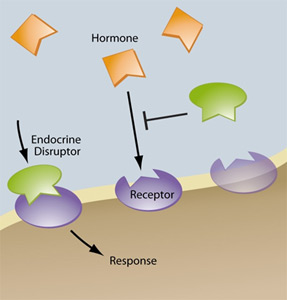



Endocrine Disruptors, Estrogen Disruptors
Exposure to endocrine disruptors can ↑ number of liver cysts and enlarge PLD liver size. Environmental endocrine disruptors, xenoestrogens, contribute to decreased sperm counts, sterility, and reproductive tumors. Endocrine disruptors have an effect on traditional endocrine glands, their hormones and their receptors (estrogens, anti-androgens, thyroid hormones, as well as the liver). PLD cysts have hormonal receptors endocrine disruptors into many of the liver's processes. The body mistakenly takes these chemicals to be true endocrine hormones and not simply disruptor chemical compounds. Liver cysts respond by growing and liver cyst size increases with a life long cumulative continued increased exposure. The good news is this can be slowed way down by diminishing endocrine disruptor exposure, by increasing the metabolism of estrogen by products through the liver (turmeric, broccoli sprouts), by using saunas, and bentonite clay baths.
Endocrine Disruptors Can ↑ PLD Symptoms
↑ liver cyst growth↑ liver size
↑ PLD cysts
Some common endocrine disruptors follows.
alcohol
ammonia
bleach
endocrine disruptors
methylparabens
nonylphenol
phenol
phytoestrogens
plastic
xenoestrogens
Phytoestrogens
Phytoestrogens are chemicals that look similar to the body's natural estrogen. Exposure to phytoestrogens will increase liver cyst growth. The body incorporates these chemicals as if they are true estrogen.
Endocrine Disruptors EWG
There are EWG suggestions for avoiding each of the following Dirty Dozen Endocrine Disruptors.
BPA
Dioxin
Atrazine
Phthalates
Perchlorate
Fire retardants
Lead
Arsenic
Mercury
Perfluorinated chemical (PFCs)
Organophosphate pesticides
Pesticides
Glycol ethers
BPA
There are approximately 870 known endocrine disruptors. Every chemical on this list has one or more verified citations to published, accessible, primary scientific research demonstrating effects on the endocrine system. During the 1930's plastic was developed as an estrogen drug. BPA or Plastic is now known as an estrogen disruptor.
Atrazine
Atrazine, a potent endocrine disruptor, does not occur naturally in the environment. It enters the environment primarily through spraying on farm crops. Liver, kidney, and heart damage has been observed in animals exposed to atrazine; we do not know if this would also occur in humans. Atrazine has been shown to cause changes in blood hormone levels in animals that affected ovulation and the ability to reproduce. Atrazine is an odorless, tasteless chemical that is appearing in our drinking water. This occurs from runoff from groundwater.Herbicides Pesticides
Discussion of the two hit mechanism exists for both kidney and liver cyst activation. According to the second hit mechanism, maintaining the integrity of your own personal DNA helps to minimize PLD symptoms. This can be best accomplished by limiting exposure to DNA destructors like pesticides and herbicides. Limiting exposure can decrease liver cyst growth in both ADPLD and ADPKD.
There is the possibility that atrazine can affect growth of PLD cystic liver size. Liver cysts contain hormone receptors that could respond with growth when atrazine exposure occurs. The European Union banned the use of atrazine in its member nations in 2003 after it found traces of atrazine in some of its drinking water supplies. In America, people are mostly exposed to atrazine through drinking water that has been contaminated as a result of using the herbicide to control weeds on farms and golf courses.
What Makes Liver Cysts Grow?

Liver cysts have receptors within their cell walls. These following compounds are similar. They ↑ liver size and cyst growth attaching to hormone receptors within the liver cysts.
BPA
Bleach
Endocrine disruptors
Hormones
Parabens
Phytoestrogens
Phthalates
Plastic
Xenoestrogens
| Useful Herbs | Useful | Useful Chemicals | Avoid Herbs | Avoid | Avoid Chemicals |
| Avoid Grains | Xenoestrogens | Useful Grains |
| Herbs Cause Hepatitis | Symptoms PLD | Safe Cosmetics |
WHO Has a Program For Endocrine Disruptors World Wide
World Health Organization has coupled with the United Nations Environment Programm and together these two organizations have come up with recommendations world wide regarding endocrine disruptors. NIEHS National Institute of Environmental Health Science supports studies to determine whether exposure to endocrine disruptors may result in human health effects including lowered fertility and an increased incidence of endometriosis and some cancers. Research shows that endocrine disruptors may pose the greatest risk during prenatal and early postnatal development when organ and neural systems are forming.
